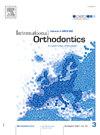En-masse maxillary anterior retraction to close the extraction space with fixed orthodontic appliances: A systematic review
IF 1.9
Q2 DENTISTRY, ORAL SURGERY & MEDICINE
引用次数: 0
Abstract
Objective
To evaluate the evidence on the treatment results and patients’ reported outcomes of the en-masse maxillary anterior retraction technique.
Material and methods
Web of Science™, MEDLINE (via PubMed®), and Scopus electronic databases and reference lists of relevant studies were comprehensively searched on September 24, 2024 with no time frame limitation but, with the language limited to English. Randomized clinical trials investigating en-masse retraction in orthodontic patients who needed maxillary first premolars extraction were selected using keywords to search the titles and abstracts before a detailed reading of each full text in the next steps. Primary outcomes included rate, duration, or amount of anterior retraction and anchorage loss while secondary outcomes included positional changes in the anterior and molar teeth, root resorption of the anterior teeth, and patients’ experiences. The Cochrane Collaboration's risk of bias tool was used for risk of bias and quality assessment of the included studies.
Results
There were 257 articles deemed potentially suitable for the review. Removing duplicates, careful reading the titles and abstracts, and applying the inclusion/exclusion criteria left 22 articles were included. The risk of bias assessment showed 3, 7, and 12 studies of “high”, “some concerns” or “low” risk of bias respectively. En-masse retraction produced similar incisor retraction and anchorage loss in about half the time needed by the two-step mechanics. Corticotomy, micro-osteoperforation, and low level laser therapy showed positive results for accelerating en-masse retraction. while piezocision and platelet rich plasma did not. Root resorption of the incisors could increase when using mini-screws, especially infra-zygomatic mini-screws.
Conclusions
There is need for future RCT on the different outcomes done according to standardized methodologies. Corticotomy, micro-osteoperforation, and low-level laser showed positive results in accelerating en-masse retraction, but the clinical significance remains unclear. Rate of tooth movement was similar in piezocision, platelet-rich plasma, and the control groups. Mini-screws, especially infra-zygomatic mini-screws, increase the chance of root resorption, but the force system arrangement is crucial.
固定正畸矫治器上颌前缩闭合拔牙间隙的系统回顾
目的评价上颌前缩术的治疗效果和患者报告的结果。材料和方法于2024年9月24日全面检索web of Science™、MEDLINE(通过PubMed®)和Scopus电子数据库及相关研究的参考文献列表,没有时间限制,但语言仅限于英语。在接下来的步骤中,在详细阅读每个全文之前,使用关键词搜索标题和摘要,选择随机临床试验,调查需要拔除上颌第一前磨牙的正畸患者的大规模退缩。主要结果包括前牙后缩的速率、持续时间或量以及支抗丢失,次要结果包括前牙和磨牙的位置变化、前牙的牙根吸收以及患者的经验。采用Cochrane Collaboration的偏倚风险工具对纳入的研究进行偏倚风险和质量评估。结果有257篇文章被认为可能适合本综述。删除重复,仔细阅读标题和摘要,并应用纳入/排除标准,最终纳入了22篇文章。偏倚风险评估分别显示有3项、7项和12项研究存在“高”、“部分关注”和“低”偏倚风险。大规模的内缩产生了类似的门牙内缩和支抗损失,大约需要两步力学的一半时间。皮质切开术、显微骨手术和低水平激光治疗对加速大面积内缩有积极的效果。而压裂和富血小板血浆则没有。使用微型螺钉,尤其是颧下微型螺钉,可增加门牙牙根吸收。结论根据标准化方法对不同结果进行随机对照试验是有必要的。皮质切开术、显微骨手术和低水平激光对加速大面积内缩有积极效果,但临床意义尚不清楚。压切组、富血小板血浆组和对照组的牙齿移动率相似。微型螺钉,特别是颧下微型螺钉,增加了牙根吸收的机会,但力系统的安排是至关重要的。
本文章由计算机程序翻译,如有差异,请以英文原文为准。
求助全文
约1分钟内获得全文
求助全文
来源期刊

International Orthodontics
DENTISTRY, ORAL SURGERY & MEDICINE-
CiteScore
2.50
自引率
13.30%
发文量
71
审稿时长
26 days
期刊介绍:
Une revue de référence dans le domaine de orthodontie et des disciplines frontières Your reference in dentofacial orthopedics International Orthodontics adresse aux orthodontistes, aux dentistes, aux stomatologistes, aux chirurgiens maxillo-faciaux et aux plasticiens de la face, ainsi quà leurs assistant(e)s. International Orthodontics is addressed to orthodontists, dentists, stomatologists, maxillofacial surgeons and facial plastic surgeons, as well as their assistants.
 求助内容:
求助内容: 应助结果提醒方式:
应助结果提醒方式:


